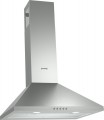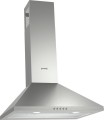Motor power
The power of the hood at maximum speed.
The more powerful the device, the more performant it is, usually. However, there is no rigid dependence here, and hoods of the same power may differ in actual performance. So it is worth evaluating power consumption in terms of power first of all: the lower this indicator, the more economical the device. And when evaluating performance, you need to look not so much at power as at the directly claimed flow of the air (see below).
Flow of air (extraction)
The performance of the hood in extraction mode at maximum speed shows the real possibilities for air purification. Since this parameter is several times less than the motor performance (maximum performance), not all manufacturers indicate this value, trying to present large and beautiful numbers. A similar situation can be observed among other devices. For example, in vacuum cleaners, the total power is many times greater than the suction power; in acoustics, mediocre brands prefer to list peak power instead of nominal power. Therefore, motor performance and extraction performance can not be compared. However, high-performance motors will also give high performance in extraction mode. And it may well be that the conditional Bosch with an extraction performance of 300 m³/h will be better than another hood with a maximum motor performance of 500 m³/h.
Max. noise level
The level of noise produced by the hood in the loudest mode of operation. Usually (but not necessarily) it is the maximum power mode. It affects the comfort during operation of the device, so
quiet hoods will be more preferable, but also more expensive.
The decibels in which the noise level is measured are non-linear units, so it is easiest to use comparison tables to estimate a specific value. Here is the simplest table for the values relevant in this case:
— 35 dB. The volume of a conversation in an undertone (but not a whisper). The lowest maximum noise value in modern hoods. Devices with such characteristics are almost guaranteed not to cause inconvenience: such noise is often blocked by other sounds, for example, the background noise of the street in an open window.
— 40 dB. The volume of a normal conversation. The maximum noise level allowed in a residential area during the day. If the hood is bought for home use, and it is supposed to be turned on often and for a long time, the noise level in the selected device shouldn't exceed this indicator.
— 50 dB. Conversation volume at medium tones.
— 60 dB. Raised conversation.
— 70 dB. Sound background on a busy street, in a crowd of people talking loudly, the sound of a vacuum cleaner motor at a distance of 2 – 3 m.
— 75 dB. Scream or loud laughter at a distance of about a metre.
— 78 – 79 dB. Loud mechanical alarm clock, motorcycle o
...r truck engine. The highest level in modern consumer-grade hoods.
Note that the actual comfort of using the device depends not only on the volume but also on the timbre (tonality) of the noise: for example, a low, even rumble is generally perceived easier than high frequencies with clanging notes. If the hood installation is unsuccessful, the actual noise level may be higher than stated in the specifications. For example, additional noise can be caused by the hum of air in the ducts or rattling from the contact of the vibrating body with the wall. However, when choosing, it is worth focusing on the noise level claimed in the specifications.Grease filter
The type of grease filter normally used in the hood. Usually, it has the appearance of a fine mesh that traps drops of fat and kitchen fumes. The grease filter can be like this:
— Metal. In this case, different materials can be used; most often, the word "metal" means a filter made of a relatively inexpensive alloy, and aluminium and stainless steel are usually listed separately (see below for more details). Common features of metal mesh are strength, durability and reusability: it is enough to wash and dry a dirty filter, after which it is ready for use again.
— Aluminium.
Filters made of aluminium alloys are considered to be very durable, because this material is highly resistant to corrosion. However, such filters are noticeably more expensive than ordinary metal ones (see above).
—
Stainless steel. Mesh made of this material has all the advantages of the metal filters described above; they are very reliable and durable, but at the same time not cheap. As a result, the use of stainless steel is typical mainly for premium hoods.
— Acrylic. A polymeric material similar to plastic. The main and the only advantage of acrylic filters is their low cost. At the same time, their service life is much shorter than that of metal ones. And some of these filters are generally disposable and cannot be cleaned after clogging. As a result, such filters are used mainly in low
...-cost models of hoods, and even then quite rarely.Carbon filter model
The model of the carbon filter compatible with the hood. For more information about such a filter, see "Ability to install carbon filter". Here we note that the carbon filter is not always supplied in a kit, and its service life is limited, periodic replacement is required. Anyway, the data on the filter model makes it much easier to find.
Duct diameter
The duct diameter characterizes the size of the hood outlet to which the ducts are connected. The standard is either
120 mm or
150 mm. In many cases, an adapter from one diameter to another can additionally be included with the device. However, when replacing the hood with a new one, it is still better to operate with the existing pipe diameter and not use adapters.

